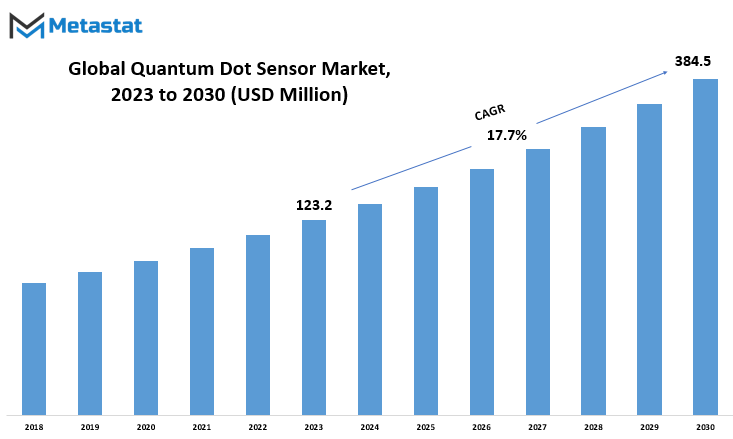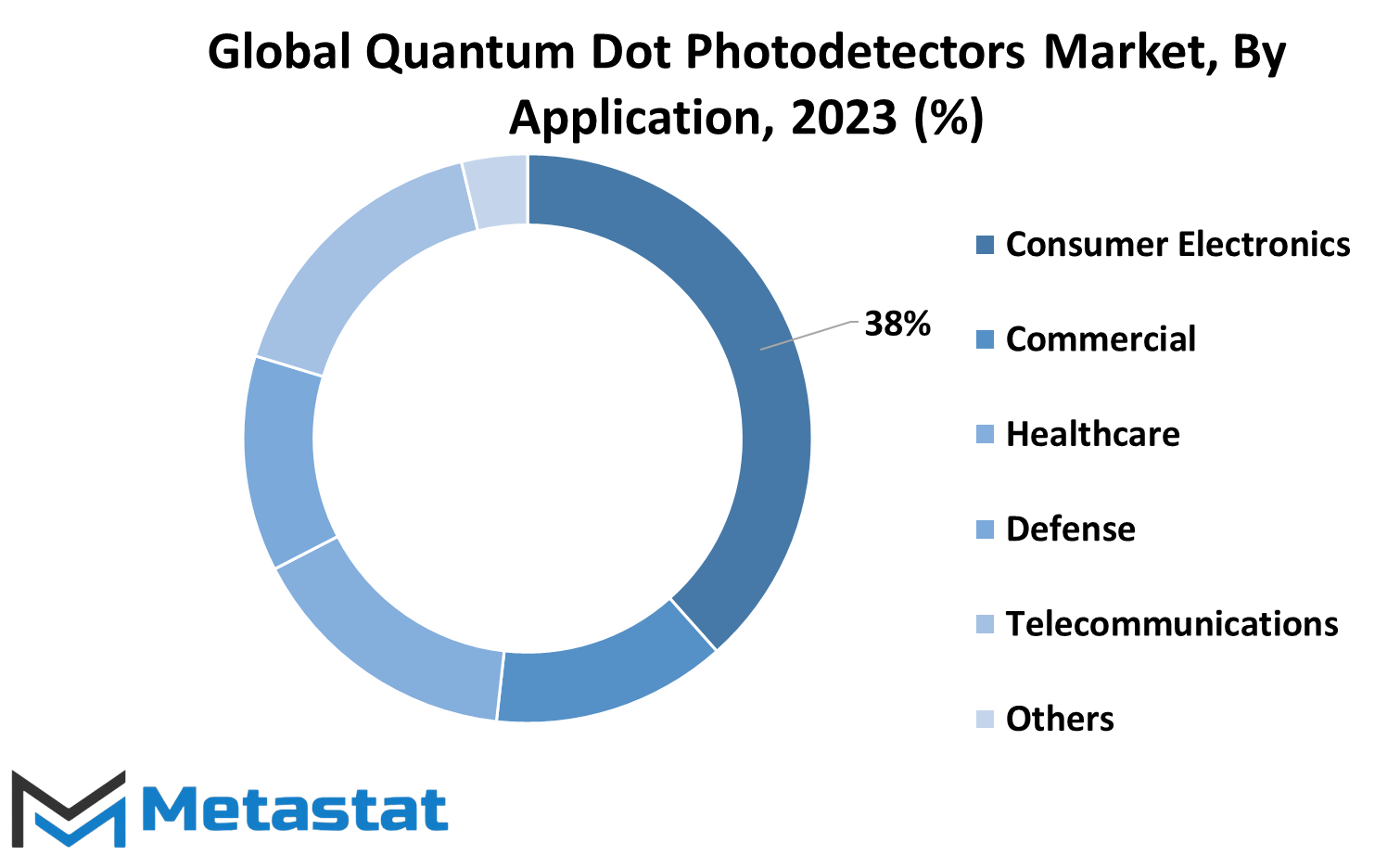MARKET OVERVIEW
In the advanced optoelectronic technologies, the Quantum Dot Photodetectors market stands as a beacon of innovation and promise. These photodetectors, harnessed from the fascinating principles of quantum dots, represent a groundbreaking leap in light sensing applications. As we delve into the essence of Quantum Dot Photodetectors, it becomes evident that their significance lies not only in their remarkable sensitivity to light but also in their ability to transcend the limitations of traditional photodetectors.
At its core, a Quantum Dot Photodetector is a semiconductor device that exploits the quantum confinement effects of nanoscale semiconductor structures known as quantum dots. This unique architecture imparts exceptional tunability to the photodetector, allowing for precise control over its spectral response. Unlike conventional photodetectors, Quantum Dot Photodetectors exhibit an unparalleled ability to capture light across a broad spectrum, from visible to infrared wavelengths.
The importance of Quantum Dot Photodetectors becomes apparent when considering their applications in diverse fields. One of the notable arenas where these photodetectors shine is laser triangulation technology. In laser triangulation, precise distance measurements are crucial, and the accuracy of these measurements hinges on the efficiency of the photodetector in capturing and converting light signals. Quantum Dot Photodetectors, with their enhanced sensitivity and tunable spectral response, play a pivotal role in elevating the precision and reliability of laser triangulation systems.
Beyond laser triangulation, Quantum Dot Photodetectors find application in areas such as medical imaging, communication systems, and environmental monitoring. Their ability to provide high-speed response, low noise, and adaptability to different wavelengths positions them as indispensable components in the ever-evolving landscape of advanced photonics.
Global Quantum Dot Photodetectors market is estimated to reach $384.5 Million by 2030; growing at a CAGR of 17.7% from 2023 to 2030.

GROWTH FACTORS
The global Quantum Dot Photodetectors market operates within a dynamic framework, influenced by various factors that drive or impede its growth. Key driving factors of the market encompass technological advancements and increasing demand for advanced imaging solutions. These factors fuel the market, propelling it forward in response to the growing need for cutting-edge photodetection technology.
However, challenges such as regulatory hurdles and potential market saturation might hamper the otherwise positive trajectory of the Quantum Dot Photodetectors market. Regulatory constraints can slow down the adoption of new technologies, while market saturation raises concerns about the market reaching its zenith, limiting further expansion.
Amidst these challenges, there exists a silver lining—innovation. Innovations in quantum dot technology, coupled with a continuous focus on research and development, present a pathway to overcome hurdles. The market's adaptability to address regulatory concerns and the ability to innovate and stay ahead of saturation issues would be crucial in sustaining growth.
Looking ahead, the Quantum Dot Photodetectors market holds promising opportunities for expansion. The increasing integration of quantum dot technology in various industries, including healthcare, consumer electronics, and defense, provides fertile ground for market growth. Additionally, the rising demand for high-performance imaging devices and displays, coupled with the growing trend of quantum dot-based products, opens lucrative avenues for the market in the coming years.
MARKET SEGMENTATION
By Material Type
The global Quantum Dot Photodetectors market can be divided based on material type, with two main segments: Cadmium-Based and Cadmium-Free. In 2022, the Cadmium-Based segment held a value of 58.9 USD Million, while the Cadmium-Free segment was valued at 47.4 USD Million.
Material type plays a crucial role in shaping the Quantum Dot Photodetectors market landscape. The two primary categories, Cadmium-Based and Cadmium-Free, showcase distinct values in terms of market valuation. In the year 2022, the Cadmium-Based segment recorded a value of 58.9 USD Million, highlighting its significance in the market. On the other hand, the Cadmium-Free segment, with a value of 47.4 USD Million in the same year, represents another substantial portion of the market.
Understanding the market dynamics by material type provides insights into the preferences and trends shaping the Quantum Dot Photodetectors industry. The notable values associated with both Cadmium-Based and Cadmium-Free segments underscore the diverse choices and applications within this technological domain. As the market continues to evolve, these material-based distinctions become crucial factors for stakeholders and businesses aiming to navigate and capitalize on the opportunities in the Quantum Dot Photodetectors sector.
By Production Type
Colloidal Synthesis, a method of producing quantum dot photodetectors, held a significant position in the market, registering a valuation of 63.4 USD Million in 2022. This production approach involves the creation of quantum dots through a colloidal solution, providing a practical and widely used method within the industry.
However, the Plasma Synthesis segment also contributed notably to the market, with a valuation of 42.8 USD Million in 2022. Plasma Synthesis stands out as another effective method in quantum dot photodetector production, offering a distinct approach compared to the colloidal counterpart.
These two production types, Colloidal Synthesis and Plasma Synthesis, represent key players in the global Quantum Dot Photodetectors market, each bringing its unique attributes to the table. As the market continues to evolve, the significance of these production methods underscores the diversity and innovation present in the field. The Colloidal and Plasma Synthesis segments, valued for their respective contributions, exemplify the dynamic landscape of quantum dot photodetector production, shaping the industry's trajectory in the years to come.
By Application
The global Quantum Dot Photodetectors market is a dynamic landscape with diverse applications driving its growth. Examining its segmentation by application sheds light on the significant contributions from various sectors.
One key sector within this market is Consumer Electronics. In 2022, the Consumer Electronics segment played a substantial role, accounting for a value of 40.7 USD Million. This category encompasses a wide array of devices that have become integral to daily life, such as smartphones, laptops, and televisions. The market's performance in this segment reflects the increasing incorporation of Quantum Dot Photodetectors in consumer electronic products, enhancing display and imaging capabilities.
Another noteworthy domain is the Commercial sector, which recorded a value of 14.2 USD Million in 2022. This sector covers a range of applications beyond individual consumer use, including business-oriented technologies and equipment. The demand for Quantum Dot Photodetectors in commercial applications is indicative of their relevance in enhancing visual technologies, possibly in displays for business presentations or other professional settings.
In Healthcare, Quantum Dot Photodetectors contributed significantly, with the Healthcare segment reaching 16.7 USD Million in 2022. The application of these photodetectors in healthcare devices and equipment underscores their role in advancing medical imaging technologies. This not only aids in diagnostics but also contributes to improving healthcare outcomes.
The Defense sector, another pivotal area, demonstrates a growing reliance on Quantum Dot Photodetectors, with an associated value of millions in 2022. The military's adoption of these technologies is likely driven by the need for advanced sensing and imaging capabilities, aligning with the sector's constant pursuit of cutting-edge technology for strategic purposes.
Telecommunications is an additional sector where Quantum Dot Photodetectors find applications, registering a value of 17.6 USD Million in 2022. This indicates their role in optimizing communication technologies, possibly in the development of high-performance optical communication systems.
Beyond the specified categories, the market extends its reach into other applications, showcasing the adaptability and versatility of Quantum Dot Photodetectors in diverse industries and settings. The value generated in this catch-all category reflects the market's ability to cater to unforeseen or niche applications, contributing to the technology's widespread adoption.
The segmented analysis of the global Quantum Dot Photodetectors market emphasizes its widespread influence across various sectors. From consumer electronics to defense and telecommunications, these photodetectors continue to evolve and make a substantial impact on diverse industries, shaping the trajectory of technological advancements in the years to come.

REGIONAL ANALYSIS
The global Quantum Dot Photodetectors market exhibits a geographical segmentation that reflects its expansive reach across different regions. This division facilitates a more targeted understanding of its presence and impact. Geographically, the global Quantum Dot Photodetectors market is delineated into North America and Europe, encapsulating the market's foothold in these key regions.
North America, a prominent player in the Quantum Dot Photodetectors market, stands as a testament to the technology's adoption and utilization in this region. The market dynamics in North America are influenced by factors such as technological advancements, research and development activities, and the integration of quantum dot photodetectors across various industries.
On the other side of the Atlantic, Europe too plays a significant role in the global Quantum Dot Photodetectors market. The region's economic landscape, technological infrastructure, and emphasis on innovation contribute to the market's growth and evolution. European industries leverage quantum dot photodetectors in various applications, reflecting a robust market presence.
This geographical division provides insights into the regional nuances and preferences that shape the Quantum Dot Photodetectors market. The market's performance in North America and Europe reflects not only the technological landscape but also the adaptability and acceptance of quantum dot photodetectors in diverse applications across these regions. As the global market continues to unfold, understanding its geographical intricacies becomes crucial for stakeholders, enabling them to navigate and capitalize on the unique opportunities presented by different regions.
COMPETITIVE PLAYERS
The global Quantum Dot Photodetectors market boasts a roster of influential players steering the industry forward. Among these key contributors to the Quantum Dot Photodetectors sector are notable names such as Hamamatsu Photonics K.K. and IQE PLC. These companies have established their prominence through significant contributions to the advancement and innovation within the Quantum Dot Photodetectors market.
Hamamatsu Photonics K.K., a leading player in the industry, has been instrumental in developing cutting-edge technologies in the realm of Quantum Dot Photodetectors. Their commitment to research and development has positioned them as a key influencer, contributing to the overall growth and evolution of the market. IQE PLC, another pivotal player, has demonstrated a similar dedication to pushing the boundaries of Quantum Dot Photodetector capabilities, solidifying their standing in the competitive landscape.
The presence of such industry giants underscores the competitive nature of the Quantum Dot Photodetectors market, where innovation and technological prowess are the driving forces. These key players play a crucial role in shaping the trajectory of the market, not only through their technological contributions but also by setting industry standards and trends.
As the Quantum Dot Photodetectors market continues to expand, the influence of key players like Hamamatsu Photonics K.K. and IQE PLC becomes increasingly significant. Their ongoing efforts to enhance the efficiency and performance of Quantum Dot Photodetectors contribute not only to their individual success but also to the overall advancement and maturation of the market as a whole.
Quantum Dot Photodetectors Market Key Segments:
By Material Type
- Cadmium-Based
- Cadmium-Free
By Production Type
- Colloidal Synthesis
- Plasma Synthesis
By Application
- Consumer Electronics
- Commercial
- Healthcare
- Defense
- Telecommunications
- Others
Key Global Quantum Dot Photodetectors Industry Players
WHAT REPORT PROVIDES
- Full in-depth analysis of the parent Industry
- Important changes in market and its dynamics
- Segmentation details of the market
- Former, on-going, and projected market analysis in terms of volume and value
- Assessment of niche industry developments
- Market share analysis
- Key strategies of major players
- Emerging segments and regional growth potential








 US: +1 3023308252
US: +1 3023308252






